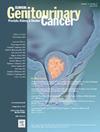Phenotypic Diversity of Immunosuppressive B Cells Associated in Urothelial Carcinoma of the Bladder
IF 2.7
3区 医学
Q3 ONCOLOGY
引用次数: 0
Abstract
Background
Urothelial carcinoma of the bladder presents a complex tumor microenvironment, with tumor-infiltrating B cells (TIL-Bs) playing a significant role in disease progression. Although their presence is acknowledged, the phenotypic diversity of regulatory TIL-Bs in bladder cancer remain underexplored.
Materials and Methods
In this study, we evaluated core B cell subsets and their immunosuppressive phenotypes in both peripheral blood (n=40) and bladder tumor tissues (n=40) to evaluate their relationship with disease severity.
Results
Our findings revealed that high-grade bladder tumors are enriched with B cells and their subsets, particularly transitional B cells and plasmacytes (plasmablasts and plasma cells). However, total memory B cells were reduced in the tumor microenvironment compared to non-tumor tissues. It was further revealed that the high-grade tumors demonstrated significant infiltration of regulatory B cells (Breg), with elevated levels of IL10+ and TGFβ+ Breg cells as well as IL-10+TGF-β+ dual-cytokine-secreting Breg cells, suggesting their role in fostering an immunosuppressive microenvironment. Memory B cells demonstrated the highest frequency of Breg phenotypes among the B cell subsets. Additionally, Tertiary Lymphoid Structure formation and frequency were associated with disease severity, the differentiated B cells and IL10+ Breg cell counts, emphasizing the importance of these structures in bladder cancer progression and the potential involvement in Breg cells formation.
Conclusion
This study demonstrates the enrichment of the bladder cancer tumor microenvironment with diverse B cell subsets, including functional Breg cells, which correlates with disease severity.
与膀胱尿路上皮癌相关的免疫抑制B细胞表型多样性。
背景:膀胱尿路上皮癌呈现复杂的肿瘤微环境,肿瘤浸润B细胞(TIL-Bs)在疾病进展中起重要作用。尽管它们的存在是公认的,但膀胱癌中调节性til - b的表型多样性仍未得到充分研究。材料和方法:在本研究中,我们评估了外周血(n=40)和膀胱肿瘤组织(n=40)中核心B细胞亚群及其免疫抑制表型,以评估其与疾病严重程度的关系。结果:我们的研究结果显示,高级别膀胱肿瘤富含B细胞及其亚群,特别是移行性B细胞和浆细胞(浆母细胞和浆细胞)。然而,与非肿瘤组织相比,肿瘤微环境中的总记忆B细胞减少。进一步发现,高级别肿瘤中存在显著的调节性B细胞(regulatory B cells, Breg)浸润,IL-10+和TGF-β+ Breg细胞以及IL-10+TGF-β+双细胞因子分泌Breg细胞水平升高,提示其在培养免疫抑制微环境中的作用。在B细胞亚群中,记忆B细胞显示Breg表型的频率最高。此外,三级淋巴结构的形成和频率与疾病严重程度、分化的B细胞和IL10+ Breg细胞计数相关,强调了这些结构在膀胱癌进展中的重要性以及可能参与Breg细胞形成。结论:本研究表明膀胱癌肿瘤微环境中存在多种B细胞亚群,包括功能性Breg细胞,其富集与疾病严重程度相关。
本文章由计算机程序翻译,如有差异,请以英文原文为准。
求助全文
约1分钟内获得全文
求助全文
来源期刊

Clinical genitourinary cancer
医学-泌尿学与肾脏学
CiteScore
5.20
自引率
6.20%
发文量
201
审稿时长
54 days
期刊介绍:
Clinical Genitourinary Cancer is a peer-reviewed journal that publishes original articles describing various aspects of clinical and translational research in genitourinary cancers. Clinical Genitourinary Cancer is devoted to articles on detection, diagnosis, prevention, and treatment of genitourinary cancers. The main emphasis is on recent scientific developments in all areas related to genitourinary malignancies. Specific areas of interest include clinical research and mechanistic approaches; drug sensitivity and resistance; gene and antisense therapy; pathology, markers, and prognostic indicators; chemoprevention strategies; multimodality therapy; and integration of various approaches.
 求助内容:
求助内容: 应助结果提醒方式:
应助结果提醒方式:


